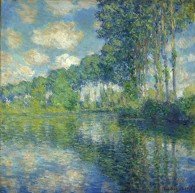Impressionism & Scotland
dal 18/7/2008 al 11/10/2008
Segnalato da
Scottish National Gallery of Modern Art
Claude Monet
Pierre-Auguste Renoir
Edgar Degas
James McNeill Whistler
Vincent Van Gogh
Paul Cezanne
Paul Gauguin
Henry Toulouse-Lautrec
Henry Matisse
18/7/2008
Impressionism & Scotland
Scottish National Gallery of Modern Art, Edinburgh
The show includes over 100 paintings by many of the greatest names in Western art: Claude Monet, Pierre-Auguste Renoir, Edgar Degas, James McNeill Whistler, Vincent Van Gogh, Paul Cezanne, Paul Gauguin, Henry Toulouse-Lautrec, Henry Matisse, the Glasgow Boys, the Scottish Colourists, and many more. An unmissable opportunity to see so many masterpieces under one roof.

The show includes over 100 paintings by many of the greatest names in Western art: Manet, Monet, Renoir, Sisley, Pissarro, Degas, Whistler, Van Gogh, Cézanne, Gauguin, Toulouse-Lautrec, Matisse, the Glasgow Boys, the Scottish Colourists, and many more.
Filling the beautiful, spacious galleries of the Royal Scottish Academy Building on Princes Street, Impressionism & Scotland is an unmissable opportunity to see so many masterpieces under one roof.
French Impressionists
The term ‘Impressionism’ is associated with a group of French artists working in and around Paris from the 1860s onwards, including Claude Monet, Pierre-Auguste Renoir and Edgar Degas.
These artists wanted to paint nature in an immediate and contemporary way. Rather than painting heroic scenes from classical mythology or biblical history, they were dedicated to the modern landscape and scenes of contemporary urban reality.
Crucially, rather than mixing their paints on the palette, the Impressionists developed a systematic technique, applying short brushstrokes of pure, unmixed colour directly onto the canvas.
The work that inadvertently gave its name to the movement was Monet’s Impression – Sunrise (1872). The critic Jules Castagnary wrote of Monet and his contemporaries: ‘If one wants to characterise them with one word that will explain them, it will be necessary to forge the new term of Impressionists.’
Impressionism Comes To Scotland
In the late nineteenth century Glasgow was the ‘Second City of the British Empire’, and some of the world’s biggest industrial and manufacturing companies were based there. Scotland’s rich mercantile collectors were keen to acquire works of art that reflected their progressive outlook, as well as their rising social status. As a result, Scotland became one of the first nations to appreciate the work of the French Impressionists.
In 1892 Arthur Kay, director of a Glasgow drapery firm, bought Degas’s L’Absinthe from the Glasgow dealer Alex Reid. The picture was famously ‘hissed’ when it appeared at auction in London: the British public was outraged by the degrading subject of a common prostitute drinking in a Parisian café
The Spread of Impressionism
In the second half of the nineteenth century the term ‘impressionist’ or ‘impressionistic’ was often used by critics in a derogatory sense to describe work seen to be lacking in academic rigour. In Britain the term was applied not only to the French Impressionists, but also to a wider range of artists outside France.
The American-born, British-based painter James McNeill Whistler was one such artist. Whistler caught the attention of the British public in 1877 with an exhibition of works at London’s Grosvenor Gallery which included Nocturne in Blue and Gold: Old Battersea Bridge. John Ruskin, the champion of Victorian anecdotal painting and academic finish, expressed his disapproval in vitriolic terms: ‘I have seen, and heard, much of Cockney impudence before now; but never expected to hear a coxcomb ask two hundred guineas for flinging a pot of paint in the public’s face.’
The Glasgow Boys
Later, in the 1880s and 1890s, the adjective ‘impressionist’ was frequently used to describe a group of artists working in and around Glasgow and known as the Glasgow ‘Boys’. They included, among others, James Guthrie and John Lavery.
Following the example of the French Impressionists the Glasgow Boys began to paint contemporary urban subjects, recording the leisure pursuits of the upper middle classes. In 1885, Lavery produced a whole series of images inspired by the social rituals associated with tennis, culminating in his masterpiece of modern life painting, The Tennis Party.
Likewise, in 1890, James Guthrie produced a large group of pastels recording tea parties and tennis matches. With their emphasis on light and fleeting atmospheric effects, they were the first truly ‘impressionist’ works that Guthrie had created.
The Scottish Colourists
At the turn of the twentieth century the Scottish Colourists - Samuel Peploe, John Duncan Fergusson, F.C.B. Cadell and Leslie Hunter - developed a modern style of painting that drew initially on Impressionism.
These artists all spent a period in France, where they encountered the work of Monet and his contemporaries. However it was Manet’s early still lifes which made the greatest impact, influencing a whole series of still lifes that Peploe and Fergusson produced around 1903-5.
Later their interests shifted to Matisse and Cézanne; Fergusson’s A Puff of Smoke Near Milngavie, for example, bears comparison with Cézanne’s La Montagne Sainte-Victoire.
Scottish National Gallery of Modern Art
75 Belford Road, EH4, Edinburgh
Open daily, 10am-5pm. Late night opening every Thursday until 7pm.
Throughout August: Open daily, 10am-6pm. Late night opening every Thursday until 7pm.
Last entry to the show is 30mins before closing time.
Tickets for Impressionism & Scotland: £8 (£6)
Free entry for Members and children aged 12 years and younger. Children aged 13 to 16 years qualify for concession.



